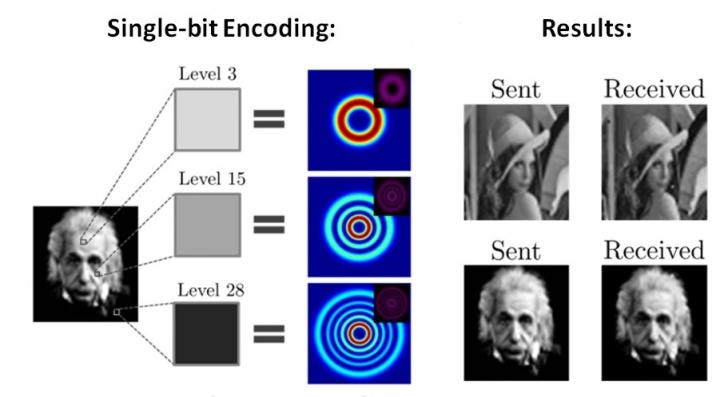Oct 20 2016
As data demands continue to grow, scientists predict that it's only a matter of time before today's telecommunication networks reach capacity unless new technologies are developed for transporting data. A new technique could help avert this bandwidth crunch by allowing light-based optical networks to carry more than one hundred times more data than is possible with current technologies.
 Researchers used more than 100 spatial modes of light to transmit an image pixel by pixel over a lab-based free-space optical network(CREDIT: Carmelo Rosales-Guzmán, University of Witwatersrand)
Researchers used more than 100 spatial modes of light to transmit an image pixel by pixel over a lab-based free-space optical network(CREDIT: Carmelo Rosales-Guzmán, University of Witwatersrand)
Laser light comes in many different shapes, or spatial modes. However, today's optical networks use just one spatial mode to carry information, limiting the amount of data that can be transmitted at one time. Researchers led by Andrew Forbes, a professor at the University of Witwatersrand, South Africa, developed a technique known as spatial multiplexing that reshapes a laser beam into many spatial modes that can each carry information.
In a paper presented at the OSA Laser Congress in Boston, the researchers demonstrate optical communication with more than 100 spatial modes by combining their new spatial multiplexing approach with wavelength division multiplexing (WDM), which uses different wavelengths of light to carry information.
"We created 35 spatial modes encoded in three different wavelengths, producing 105 total modes," said Carmelo Rosales-Guzmán, research fellow and first author of the paper. "Our new method might serve as the basis for future communication technologies."
The researchers demonstrated that their technique can transmit data with 98 percent efficiency in a laboratory free-space optical network, which uses light to transmit information over the air. The scientists say the approach should also work in optical fibers, the basis for fiber-optic communications.
Increasing bandwidth with more light modes
The new technique makes use of light with an orbital angular momentum, which gives it a twisted, or helical, shape. Different spatial modes can be created by varying the number of twists, known as the azimuthal degrees of freedom. While other scientists have been exploring the use of azimuthal degrees of freedom for increasing bandwidth, recent research showed that even though, in theory, the set of modes with orbital angular momentum is infinite, in practice there aren't enough modes available to make significant improvements.
Forbes' team solved this problem by using the azimuthal degrees of freedom plus another variable known as a radial degree of freedom. Each azimuthal degree of freedom can have, in theory, an infinite amount of radial degrees of freedom, but there are practical limitations that restrict this number. Because all the modes are orthogonal to each other, the signals don't get mixed up as they travel and can be separated upon arrival at their destination. The researchers say that this is the first time two spatial degrees of freedom have been used to optically encode information.
Key to this new approach is an optical device known as a spatial light modulator. The researchers used one spatial light modulator to shape the laser light into the various modes and another to reverse the process on the receiving end.
"One of the advantages of our approach is that we only need a single detector to demultiplex all the spatial modes to recover all the information," said Rosales-Guzmán. "This is faster than other approaches for increasing bandwidth that need multiple detectors."
Sending pictures pixel by pixel
To test the new technique, the researchers used it to encode a grayscale and color image. Each image was sent across a communication link pixel by pixel and then each pixel was recovered to reconstruct the image. For the grayscale image, each gray level was linked to a separate spatial mode, allowing transmission of 105 gray levels.
"In this demonstration, sending a 10,000-pixel image took 5 to 7 minutes," said Rosales-Guzmán. "However we could increase that speed by sending two or four pixels at the same time or by using many more wavelengths."
Real-world free-space optical networks -- which can transfer information between buildings, for example -- come with many challenges that aren't present in the lab. As a next step, the researchers are partnering with experts in free-space communication to adapt their technique for practical applications.
"We are working with a company in South Africa that already makes a device that has the ability to use different spatial modes for free space communication," said Rosales-Guzmán. "We are interested in trying to increase the bandwidth of their device to four times what it is capable of now."